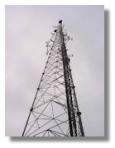On January 26th Admiral Jamie Barnett of the FCC spoke about the National Broadband Plan, which is now due out on March 17th (and I understand New York City, Boston and other cities with large Irish-American populations plan to have parades in honor of the plan that day, too!)
As a CTO, I’m so immersed in technology that I’m not sure “broadband” means anything to the average American (if an “average” American exists). Certainly most Americans are now at least aware of the Internet and use technology in their lives, even if that tech is nothing more than a cell phone or ATM. But all you have to do is watch the security lines at any airport and see all the laptops and luggables and cell phones and DVD players and other associated smart lumps of plastic dumped on the scanner lines to know that tech is ubiquitous in most people’s lives.
A significant fraction of people know about broadband and what it means. In Seattle, some 84% of homes have an Internet connection, 75% have something faster than dial-up and 88% have a computer at home. Of course Seattle’s got a reputation as a city of high tech folks (an image Bill Gates, Steve Ballmer and I work hard to polish). But even nationwide 79% of homes have an Internet connection and 63% are faster than dial-up. The source for these stats is here.
These are numbers are hard to fathom when one considers the web didn’t exist 20 years ago, and most people probably thought “Internet” had something to do with basketball, volleyball, tennis or another “net-centric” sport.
Admiral Barnett heads the Homeland Security and Public Safety Bureau at the FCC. He’s charged with making wireless spectrum available to government in general and specifically to the law enforcement, firefighting and emergency medical agencies who keep the public safe. He spoke at the Winter Summit of Association of Public Safety Communications Officials on January 26th, and gave us a glimpse of what the National Broadband Plan will contain.
Admiral Barnett’s remarks centered on wireless spectrum for use by first responders. About 10 Megahertz is available nationwide for public safety, but the license for that is held by a single nationwide organization. Yet most police, fire and emergency medical agencies are operated by cities and counties. Given this paradoxical situation, 17 states and cities have requested waivers from the FCC to use that spectrum in their local areas to immediately create networks for their use.
And why is the spectrum required? These new wireless networks hold promise that cops in police vehicles can see videos of crimes in progress as they race to crime scenes, or rapidly access building plans, images and video. Have a peek at a report prepared by PTI and APCO here for more uses.
According to Admiral Barnett, those waivers may be granted later this year so we can get started building the network. The FCC is very interested in public-private partnerships to build the networks because many jurisdictions don’t have funds to construct such networks for themselves. Luckily, commercial cell phone carriers like Verizon and AT&T, and companies like Motorola and Alcatel-Lucent have signed on in support of this plan, and are developing new networks including LTE (long term evolution) for not only their own networks but also for public safety use. This means public safety agencies could use a network built and funded by taxpayers (more resilient, better priority, less costly) for most of their work, but could roam only the commercial carriers’ networks when necessary. This is in stark contrast to today’s networks, where police/fire radios are incompatible with the cell phone networks. The best of both worlds!
It looks like the FCC will encourage these partnerships in its plan.
The FCC also knows that funding will be required to construct these networks. Admiral Barnett understands funding is required not just to build the networks, but to operate them. Besides public-private partnerships, the FCC is floating the idea of an Emergency Response Interoperability Center (ERIC) to pushing forward on a national public safety wireless network. We’ll hear more about this on February 10th.
Finally, Barnett said “next generation 911” will also be recognized in the national broadband plan. Right now, the only way to get information to a 911 center is to … well … telephone 911! But many citizens’ cell phones have the capability to do text messages, take photos and video. Yet 911 centers have little or no capability to accept such media, which can be critical to rapidly apprehending perpetrators and rendering aid to victims. We higher-speed land line fiber optic networking between 911 centers and other public safety and government facilities too, and I hope that will be in the Plan.
Twenty years ago, very few people knew of the Internet or Web. Now it is an indispensible part of most people’s lives and a vital component of our HomeCity security and public safety. But we need more network SPEED, both wired and wireless. The National Broadband Plan could be, with a bit of vision by the FCC, a roadmap to the future of the nation.




Google made an announcement that they will be testing a 1Gbps that they intend to make open for all.
http://arstechnica.com/tech-policy/news/2010/02/your-new-isp-google-launches-1gbps-fiber-to-the-home-trial.ars